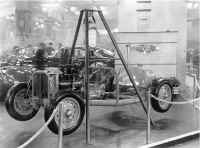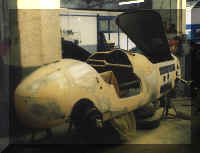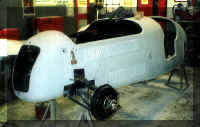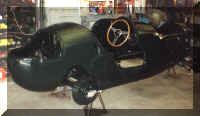Introductory Notes
David Starling
February, 2001
The following notes are compiled at this time, so as to give a history of YH7559. They are the result of several years of research carried out since I purchased the car in the UK in 1997 and since bringing the car to NZ in 1999. Copies of all correspondence are available, the originals been on file. Likewise, references made to books are indicated, and copies of the relevant material are available.
Bibliography:
"Bristol Cars & Engines", LKJ Setright, MRP, 1974 (out of print)
"Frazer Nash", David Thirlby, 1977, Haynes (out of print)
"From Chain Drive to Turbocharger", Denis Jenkinson, ("C to T DSJ"), 1984, Guild Pub (out of print)
"From Roadster to Legend", Rainer Simonds, 1996, Bruckmann
"Frazer Nash - What Memories That Name Arouses", R. L. Jennings
"Frazer Nash, 1923 -1957", Thirlby & Bancroft, 2000, Thirlby Publicity
These are the only books available on the subject; the ones by Jennings and Simonds are the most informative from an engineering viewpoint. Of the others, errors are to be found, again see letter from Thirlby. Even Jenkinsonís book, which had been taken as the definitive source due to his position as AFN archivist, has now been shown to contain mistakes. Jennings alone gives the inside information from the AFN works, highlighting the problems that existed with the dubious quality of Bristol engineering, something that all others fail to mention.
My personal credentials are simply those of an owner of several of these cars over the last forty years, having carried out total strips and rebuilds on both my own and friendís cars over that time. I can fairly say that there is not one part of these cars with which I am not familiar.
Please remember, it is now fifty years since these cars were made. They were built as sports/racing cars, a high-risk category. Over the last fifty years, all have had replacements - some of major items. One well-known "original" car has had at least three new bodies. Thin aluminium sheet becomes brittle, cracks and corrodes, replacement becomes cheaper than repair. In recent times, the quest for originality has become crazy, no piece of machinery fifty years of age will not have required major work during that time, yet claims are made that cars are just as they left the factory. In truth, many are only original in registration number and chassis plate, having undergone total rebuilds.
Denis Jenkins on in his book "Directory of Historic Racing Cars" came up with a set of categories for cars without a continuous history, these were:
Resurrection
Reconstruction
Facsimile
As my car was effectively killed by the works in 1950, I now consider "resurrection" most appropriate, as it did indeed arise from the dead. That story now follows.
The History of 1948 Frazer Nash Le Mans Replica YH7559, powered by Engine Number 1051
AFN, makers of Frazer Nash cars, exhibited on their stand at the 1948 London motor show, a rolling chassis of their new sports car. The chassis was suspended from a large spring balance, supported by a tripod. This chassis was number 421/100/003, fitted with engine number 1051. This been the very same engine fitted in my car today. (see photo, also "C to T DSJ", page 141)
This chassis was sold to racing driver Mike Tenbosch, who after having it fitted with the ugly all enveloping Fox & Nichol body, which the works had removed from E2 (the second experimental car). He entered the car for the 1949 Mille Miglia, starting as race number 627, but failing to finish due to mechanical trouble. (see "C to T DSJ", pages 233-236; also letter from RAC to self, reasons for engine stamping by that authority; photo of car at start).
After failing to complete the Mille Miglia, Tenbosch returned his car to the AFN works in late 1949. Early in 1950, it was completely dismantled. The chassis of 003 been used to build 421/100/121, engine no. 1051, which had powered the car in the Mille Miglia race, was then fitted into 421/100/116. All these facts are recorded in Jenkinsonís book ("C to T DSJ", page 303, appendix 3).
Subsequently 421/100/116 was fitted with a later type engine at AFN works and engine no. 1051 returned to their stores. Unbelievably in 1954, engine no. 1051 left AFN works for a third time in another new car, 421/200/190. In 1956, this car was fitted with a Bristol BS4 unit at the works of AFN, so once again the historic ex-Mille Miglia engine 1051 was back in AFN stores, remaining there until car production ended in the late fifties.
After that it was in the hands of Betty Haig, who raced a Frazer Nash. Later it passed into the hands of the well-known Cooper Bristol racer, Roddy McPherson, probably the foremost authority on the Bristol engine (see letter to the registrar of the F/N section of the VSCC, also registrar's letter to myself, confirming 1051ís provenance beyond doubt).
McPherson sold the engine and its gearbox in the late sixties to a Frazer Nash enthusiast who already had many genuine FN parts. A decision was made to build a car around this historic engine. The vital item with which to start been a chassis. As no original chassis was available, a completely new frame was made at Buxted by Crosthwaite & Gardiner, been identical in every way to the original. The fact that this was done at the time that C & G had jigs set up for the rebuild of 421/100/006 (now owned by my friend Peter Jackson) for Stephen Curtis, ensured that it was correct. This chassis was numbered 421/100/003R, to indicate that it was a replacement for the original 421/100/003 from which engine 1051 was removed in 1950 by the AFN works (see letter from C & G). The new aluminium bodywork was made for the car by Peel's of Kingston on Thames, who at times had made bodies for AFN. This firm also made the new bodywork now on Jackson's 421/100/006, using the same buck, ensuring that the body form is exactly as per original.
The work of assembling the various parts into a complete vehicle was undertaken for the then owner by Gerald Brigham, over a number of years. When purchased in 1997, the car was still not finished, twenty odd years after the project was started. I personally dismantled the car completely, sending the chassis/bodywork into the paint shop for preparation and painting, this taking a month. Whilst the engine and gearbox were out, the flywheel was skimmed and a complete new clutch assembly fitted, all brake cylinder rubbers replaced, along with linings and the front spring reset. After six months solid work, the car was completed and on the road.
YH7559 - 1998
Apart from engine 1051's competition history in the 1949 Mille Miglia, it has further historical significance, in that it is the oldest postwar Frazer Nash engine extent. Jenkinson, in his book ("C to T DSJ"), says that an initial batch of four engines was produced by Bristol for Frazer Nash in 1948. These, he states, to be standard 85 BHP Bristol units. This has been proved to be incorrect. In fact, AFN gave a specification to Bristol based on their experience of racing the prewar BMW 328 cars, for which they held the agency. These first four engines were: 1051, 1053, 1055 & 1056. All were quite different to the normal Bristol unit by way of different crankshafts, camshafts, cylinder heads, valve sizes and distributor. Power output was raised from 85 BHP in the standard Bristol unit to 125 BHP in the Frazer Nash (see dyno test sheets on 1051 supplied by Jennings, who undertook the tests during his time at AFN in the 1950's, also an extract from his book). As stated by Jennings, these tests showed that power output of these first engines to be comparable with the later "FNS" series.
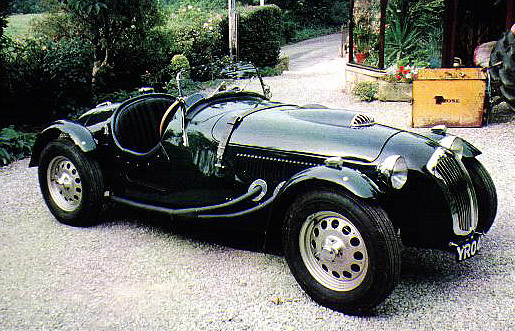
YRO 405 - Now YH7559
Finally as the reader will be aware, this car is a "bitsa", made up of parts and not a factory-constructed car with continuous history. It is however, built with genuine Frazer Nash components, apart from the replacement chassis, as no genuine one was available. It does contain all the right bits, and as such provides a suitable home for its historic engine. Needless to say it drives just as would be expected of a factory-built Frazer Nash.
I doubt if any other manufacturer of motorcars has ever sold the same engine as new in three different cars and that after it had competed in one of the worldís most grueling motor races, the Mille Miglia!
(Footnote: In January 2001, I competed in the VCC Dreyers Rock road speed hillclimb with the car, setting fastest time of the day, 60.46 seconds for the 1.1 mile course.
Posted: May 22, 2001
